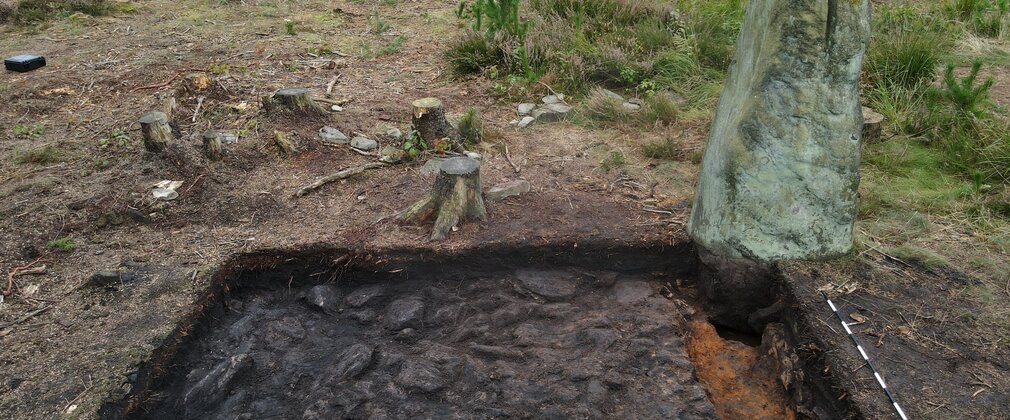
Saturday 22 March 2025
3,700-year-old stone circle discovered in Derbyshire forest
Bronze Age ceremonial site found in Forestry England woodland sheds new light on prehistoric landscape
A team of archaeologists has discovered that what was thought to be a single standing stone in a Derbyshire forest, is part of a larger prehistoric complex, including an ancient stone circle with a ceremonial platform dating back to the early Bronze Age. Excavations by Forestry England in partnership with Time Team, have revealed new information about the Farley Moor standing stone in Farley Wood near Matlock.
Standing two metres tall and half a metre wide, the stone, which is the third largest in the Gritstone Moors stretching across the Peak District and Yorkshire Dales, was previously believed to be an isolated monument. However, the excavations uncovered evidence of a ceremonial platform beside it, with the main stone intentionally placed above a natural spring. The archaeology team also identified that another five nearby stones would have once been standing, creating a stone circle or oval, stretching 25 metres by 23 metres. Carbon dating has put the feature at 1,700 BCE.
Stone circles and henges are amongst the most common ceremonial monuments of the second and third millennia BCE and the newly discovered Farley Moor stone circle is one of 25 other stone circles in the Peak District. A larger landscape survey has also revealed that there is potential for many more prehistoric monuments to be found in the area, including additional stone circles.
Dr Lawrence Shaw, Forestry England's Lead Historic Environment Advisor, said:
"This discovery is hugely significant and transforms our understanding of the Farley Moor site. What we've uncovered is evidence of a much more complex ceremonial landscape, which the original standing stone is part of. The stone platform predates the standing stone itself, suggesting continuous ritual use of this site over hundreds of years, strongly linked to the water and the importance it held for Bronze Age communities.
“We often celebrate our forested landscapes for their natural beauty and ecological significance, yet they also harbour some of England’s most extraordinary historical sites, monuments and stories. The Farley Moor stone circle is one such story and an example of the way the nation’s forests in Forestry England’s care have more to discover than the trees we love. The forests are living archives safeguarding nearly 100,000 known archaeological sites. This is a rich heritage we want to bring alive and connect people to.”
Dr Derek Pitman, Associate Professor of Archaeology and Anthropology at Bournemouth University, said:
“It’s a dream come true to get to work on such a significant prehistoric monument. The scale of activity that likely existed in that landscape highlights the impact of Bronze Age ritual life far beyond headline sites like Stonehenge. This project also showcases the value of investigating sites that have been hidden in the nation’s forests for the last few decades and implies a wealth of archaeology still waiting to be explored.”
The site is at the head of a water catchment that feeds into Bentley Brook and ultimately the River Derwent, highlighting the importance of the water source to the Bronze Age communities who lived and performed their ceremonies within this landscape.
The forest setting and Forestry England’s care of Farley Wood has helped preserve the stone circle feature and remaining standing stone. Forestry England will continue to protect the site meeting the UK Forestry Standard, which says how forests should be sustainably managed. Though not a scheduled monument, Forestry England will manage the entire site of the circle as though it were one, to ensure it is preserved.
The archaeology team hopes to return to the site next summer to do a longer investigation looking in more detail at some of the newly identified stones. They plan to try answering some of the questions the discovery has prompted, including when this site was first created and establishing how big the larger ritual complex is.
Local archaeology enthusiast George Bird had for some time suggested the stone might be part of a larger monument, and his interest prompted the investigation which brought together the small team of specialists.
The full story of the discovery will feature in a Time Team episode airing on their official YouTube channel on Saturday 22nd March.
Notes to editor:
- Images and video footage from Forestry England are available here. Please credit Time Team.
- Forestry England manages and cares for the nation’s 1,500 woods and forests, with over 285 million visits in 2023/24. As England’s largest land manager, we shape landscapes and enhance forests for people to enjoy, wildlife to flourish and businesses to grow. We are continuing the work we have already started to make the nation’s forests resilient to climate change and by 2026 we will:
- create at least 6,000 more hectares where we integrate wilding activities in our productive forests.
- increase the diversity of visitors to the nation’s forests and have one million hours of high-quality volunteer time given to the nation’s forests.
- plant at least 2,000 hectares of new, high quality, woodlands.
For more information visit forestryengland.uk. Forestry England is an agency of the Forestry Commission.
- The nation’s forests are home to 100,000 archaeological sites and monuments including 750 scheduled monuments and 30 registered parks and gardens. Forestry England has recently published Rooted in History: Our Historic Environment Story –which uncovers some of the remarkable stories hiding within the nation’s forests.
- About Time Team: Time Team is a British archaeology series watched by millions across the globe. Currently celebrating its 30th anniversary, the programme launched on the UK’s Channel 4 in 1994, running for 20 series and countless specials that have been exported worldwide. Time Team returned in 2021, and have just exceeded their target of having 10,000 paying supporters on the membership platform, Patreon. Recent digs include an Iron Age village, an Anglo-Saxon cemetery, and a month-long residency at the iconic Sutton Hoo.
New and 'classic’ episodes are now available to watch online, via the Time Team Official and Time Team Classics YouTube channels, serving a thriving international fanbase keen to connect with the past.
Joining Time Team on Patreon gives members behind-the-scenes access during the filming of new episodes, alongside exclusive content including masterclasses, Q&As and live session with the team.
Time Team has funded over 280 excavations in the UK and is one of the country’s biggest supporters of archaeology. Over the years, Time Team has enjoyed unrivalled access to celebrated landmarks including Westminster Abbey, Buckingham Palace and Windsor Castle. Time Team’s partnership with the National Trust at Sutton Hoo, builds on a foundation of working on some of Britain’s world’s most iconic sites.
For more information on Time Team, please visit www.timeteamdigital.com. To become the latest member of the team, join Time Team on Patreon: www.patreon.com/TimeTeamOfficial
Media Contact:
Naomi Fuller, Media Relations Manager | media@forestryengland.uk |
For Time Team press enquiries, contact: kirsty@timeteamdigital.com
